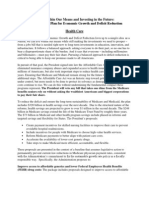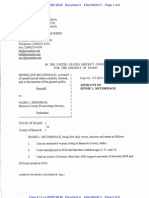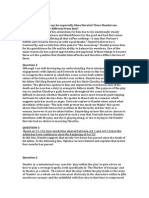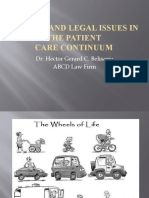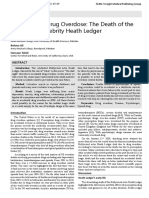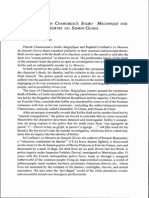Professional Documents
Culture Documents
CA3 Opinion (New Jersey Physicians) (8.3.11)
Uploaded by
sarahkliffOriginal Description:
Copyright
Available Formats
Share this document
Did you find this document useful?
Is this content inappropriate?
Report this DocumentCopyright:
Available Formats
CA3 Opinion (New Jersey Physicians) (8.3.11)
Uploaded by
sarahkliffCopyright:
Available Formats
Case: 10-4600
Document: 003110614158
Page: 1
Date Filed: 08/03/2011
PRECEDENTIAL UNITED STATES COURT OF APPEALS FOR THE THIRD CIRCUIT _____________ No. 10-4600 _____________ NEW JERSEY PHYSICIANS, INC.; MARIO A. CRISCITO, M.D.; PATIENT ROE, Appellants v. PRESIDENT OF THE UNITED STATES; SECRETARY OF THE UNITED STATES TREASURY; SECRETARY OF THE UNITED STATES DEPARTMENT OF HEALTH AND HUMAN SERVICES; THE ATTORNEY GENERAL OF THE UNITED STATES _____________ On Appeal from the United States District Court for the District of New Jersey (Civil No. 10-cv-01489) District Judge: Hon. Susan D. Wigenton Argued June 22, 2011 Before: CHAGARES, JORDAN, and GREENAWAY, JR. Circuit Judges.
Case: 10-4600
Document: 003110614158
Page: 2
Date Filed: 08/03/2011
(Filed: August 3, 2011) Robert J. Conroy (Argued) R. Bruce Crelin Kern Augustine Conroy & Schoppmann, P.C. 1120 Route 22 East Bridgewater, NJ 08807 Counsel for Plaintiffs-Appellants Beth S. Brinkmann (Argued) Mark B. Stern Alisa B. Klein Dina B. Mishra Attorneys, Appellate Staff Civil Division, Room 7531 U.S. Department of Justice 950 Pennsylvania Ave. NW Washington, D.C. 20530 Counsel for Defendants-Appellees ____________ OPINION ____________
CHAGARES, Circuit Judge. This appeal concerns a challenge to the Patient Protection and Affordable Care Act (referred to as the Health Care Act or the Act). The plaintiffs object
Case: 10-4600
Document: 003110614158
Page: 3
Date Filed: 08/03/2011
primarily to the Acts minimum essential coverage provision, more commonly referred to as the individual mandate. The mandate, when it becomes effective in 2014, will require all non-exempt applicable individuals either to maintain a certain minimum level of health insurance or pay a monetary penalty. The plaintiffs complaint asserts, generally, that the entire Health Care Act is unconstitutional because the individual mandate exceeds Congresss authority to pass laws. The District Court dismissed the complaint without reaching the merits of this challenge. Rather, the District Court held that the plaintiffs failed to plead adequately injury in fact and, therefore, did not meet their burden to demonstrate standing. The plaintiffs now appeal that determination. For the reasons stated below, we will affirm. I. A. The plaintiffs are Mario A. Criscito, M.D., a licensed New Jersey physician, Patient Roe, a patient of Dr. Criscitos, and New Jersey Physicians, Inc., a non-profit corporation that has as a primary purpose the protection and advancement of patient access to affordable, quality healthcare. Appendix (App) 32a. Dr. Criscito is the only member of New Jersey Physicians, Inc. identified by the plaintiffs in their pleadings. The defendants are four governmental officials sued in their official capacities: President Barack Obama; Timothy Geithner, the United States Secretary of the Treasury; Eric Holder, the United States Attorney General; and Kathleen Sebelius, the Secretary of Health and Human Services.
Case: 10-4600
Document: 003110614158
Page: 4
Date Filed: 08/03/2011
The complaint contains minimal allegations pertaining to the plaintiffs provision or receipt of health care. The complaint alleges that Dr. Criscito treats patients in the course of his individual practice of medicine, and that [s]ome of those patients pay [him] for his care and do not rely on a third-party payor to do so on their behalf. App. 32a-33a. The complaint also alleges that Roe is a patient of Dr. Criscito who pays himself for his care and that he is a citizen of the State of New Jersey who chooses who and how to pay for the medical care he receives from Dr. Criscito and others. App. 33a. Regarding New Jersey Physicians, Inc., the complaint asserts only that the organizations members and their patients will be directly affected by the legislation at issue [i.e., the Health Care Act] . . . should the [legislation] become effective. App. 32a. B. Only two sections of the Health Care Act1 are relevant to this appeal. The first is the previously mentioned individual mandate, 26 U.S.C. 5000A. When it takes effect in 2014, the mandate will require all applicable individual[s] to either obtain a level of health insurance that qualifies as minimum essential coverage or pay a penalty. 26 U.S.C. 5000A(a), (b), (c). The Act defines an applicable
1
Pub. L. No. 111-148, 124 Stat. 119 (2010), as later amended by the Health Care and Education Reconciliation Act of 2010, Pub. L. No. 111-152, 142 Stat. 1029.
Case: 10-4600
Document: 003110614158
Page: 5
Date Filed: 08/03/2011
individual to be any United States citizen, national, or lawfully present alien unless that individual has a valid religious exemption or is presently incarcerated. 26 U.S.C. 5000A(d). Not all applicable individuals are subject to the individual mandate, however. The Act exempts certain applicable individual[s], including those whose household income is insufficient to require them to file a federal income tax return, those whose premium payments exceed eight percent of their household income, and those who establish that the individual mandate imposes a hardship. 26 U.S.C. 5000A(e). All non-exempt applicable individuals must comply with the individual mandates requirement and acquire minimum essential coverage. This minimum essential health insurance coverage may be obtained in various ways, such as by enrolling in employer-sponsored insurance plans, individual market plans, or certain government-sponsored programs such as Medicare or Medicaid. 26 U.S.C. 5000A(f). The second relevant provision is the employer responsibility provision, 26 U.S.C. 4980H. This provision only applies to applicable large employer[s], which are defined as employers that employ fifty or more full-time employees on average over a calendar year. 26 U.S.C. 4980H(c)(2)(A). The employer responsibility provision penalizes such employers if they fail to offer their full-time employees the opportunity to enroll in an employer-sponsored insurance plan that satisfies the individual mandates minimum essential coverage requirement. 26 U.S.C. 4980H(a).2 Like the individual mandate, the employer
2
In addition, for an applicable large employer to be penalized, at least one of the employers full-time employees
Case: 10-4600
Document: 003110614158
Page: 6
Date Filed: 08/03/2011
responsibility provision will take effect in 2014. 26 U.S.C. 4980H(d). C. The plaintiffs initiated this action by filing a complaint in the United States District Court for the District of New Jersey on March 24, 2010. On March 30, 2010, the plaintiffs filed their First Amended Complaint (referred to primarily as the complaint throughout). The defendants challenged the plaintiffs invocation of the District Courts jurisdiction pursuant to 28 U.S.C. 1331, and in an opinion dated December 7, 2010, the District Court granted the defendants motion to dismiss on the ground that it lacked subject matter jurisdiction. Specifically, the District Court held that all three of the plaintiffs failed to allege the requisite injury in fact and thus did not meet their burden to demonstrate standing. The District Courts opinion did not address the defendants alternative jurisdictional arguments or the merits of the plaintiffs constitutional challenge. This timely appeal followed.
II. Article III of the United States Constitution limits the jurisdiction of federal courts to the resolution of [c]ases and [c]ontroversies. U.S. Const. art. III, 2. This language must receive a premium tax credit or cost-sharing reduction through a health benefit exchange. 26 U.S.C. 4980H(a).
Case: 10-4600
Document: 003110614158
Page: 7
Date Filed: 08/03/2011
restricts the federal judicial power to the traditional role of the Anglo-American courts and thereby prevents courts from taking possession of almost every subject proper for legislative discussion and decision. Ariz. Christian Sch. Tuition Org. v. Winn, 131 S. Ct. 1436, 1441-42 (2011) (citations and quotation marks omitted). No principle is more fundamental to the judiciarys proper role in our system of government than the constitutional limitation of federalcourt jurisdiction to actual cases or controversies. Simon v. E. Ky. Welfare Rights Org., 426 U.S. 26, 37 (1976). Courts enforce the case-or-controversy requirement through the several justiciability doctrines, which include standing, ripeness, mootness, the political-question doctrine, and the prohibition on advisory opinions. Toll Bros., Inc. v. Twp. of Readington, 555 F.3d 131, 137 (3d Cir. 2009). This appeal implicates standing, [p]erhaps the most important of these doctrines. Id. (quotation marks omitted). Standing is every bit as important in its circumscription of the judicial power of the United States as in its granting of that power. Valley Forge Christian Coll. v. Ams. United for Separation of Church & State, Inc., 454 U.S. 464, 476 (1982). The three irreducible constitutional elements of standing are: (1) an injury in fact; (2) a causal connection between the injury and the conduct complained of the injury has to be fairly traceable to the challenged action of the defendant, and not the result of the independent action of some third party not before the court; and (3) a showing that it be likely, as opposed to merely speculative, that the injury will be redressed by a favorable decision. Lujan v. Defenders of Wildlife, 504 U.S. 555, 560-61 (1992) (alterations, citations, and quotation marks omitted). The
Case: 10-4600
Document: 003110614158
Page: 8
Date Filed: 08/03/2011
only constitutional element at issue on this appeal is the first one injury in fact. To establish injury in fact, a plaintiff must allege an injury that is both (1) concrete and particularized and (2) actual or imminent, not conjectural or hypothetical. Id. (quotations omitted). Each of these definitional strands imposes unique constitutional requirements. An injury is concrete if it is real, City of L.A. v. Lyons, 461 U.S. 95, 102 (1983), or distinct and palpable, as opposed to merely abstract, Whitmore v. Arkansas, 495 U.S. 149, 155 (1990) (quotation marks and citations omitted), while an injury is sufficiently particularized if it affect[s] the plaintiff in a personal and individual way, Lujan, 504 U.S. at 560 n.1. The second requirement actual or imminent, not conjectural or hypothetical makes plain that if a harm is not presently or actual[ly] occurring, the alleged future injury must be sufficiently imminent. Imminence is somewhat elastic, Lujan, 504 U.S. at 564 n.2, but requires, at the very least, that the plaintiffs demonstrate a realistic danger of sustaining a direct injury, Babbitt v. United Farm Workers Natl Union, 442 U.S. 289, 298 (1979) (emphasis added); see also Lujan, 504 U.S. at 564 n.2 (requiring that an imminent injury be certainly impending (quotation marks omitted)). In other words, there must be a realistic chance or a genuine probability that a future injury will occur in order for that injury to be sufficiently imminent.3
3
The Supreme Court has indicated that there may be a temporal component to imminences probabilistic limitation. McConnell v. FEC, 540 U.S. 93, 226 (2003) (holding that an alleged injury in fact that will not occur for at least six years is too remote temporally to satisfy Article III standing),
Case: 10-4600
Document: 003110614158
Page: 9
Date Filed: 08/03/2011
III. The defendants present a facial challenge to subject matter jurisdiction, contesting the sufficiency of the plaintiffs pleadings. We exercise plenary review over the District Courts dismissal on this basis, Common Cause of Pa. v. Pennsylvania, 558 F.3d 249, 257 (3d Cir. 2009), accepting all allegations as true and construing those allegations in the light most favorable to the plaintiffs, see Gould Elecs. Inc. v. United States, 220 F.3d 169, 176 (3d Cir. 2000).4 Only one of the three named plaintiffs must establish standing in order for a court to consider the merits of their challenge to the Health Care Act. See Rumsfeld v. Forum for Academic & Institutional Rights, Inc., 547 U.S. 47, 52 n.2 (2006). Each plaintiff bears the burden of demonstrating standing with the manner and degree of evidence required at the successive stages of the litigation. Lujan, 504 U.S. at 561. Accordingly, given the procedural posture of this case, general factual allegations of injury resulting from the defendants conduct may suffice. Id. Even at the motion to dismiss stage, however, [i]t is a long-settled principle that standing cannot be inferred argumentatively from averments in the pleadings but rather must affirmatively appear in the record. FW/PBS, Inc. v. City of Dallas, 493 U.S. 215, 231 (1990) (internal citation and quotation marks omitted). Ultimately, [a] federal court is powerless to create its own overruled on other grounds, Citizens United v. FEC, 130 S. Ct. 876 (2010).
4
We have appellate jurisdiction under 28 U.S.C. 1291.
Case: 10-4600
Document: 003110614158
Page: 10
Date Filed: 08/03/2011
jurisdiction by embellishing otherwise deficient allegations of standing. Whitmore, 495 U.S. at 155-56. IV. In light of the disposition below, the only issue before this Court is whether the plaintiffs have met their burden in pleading injury in fact. We will assess the allegations relevant to each plaintiff in turn. A. The only allegations pertaining to any injury in fact suffered by Patient Roe are as follows: (1) Roe is a patient of Dr. Criscito who pays himself for his care, and (2) Roe is a citizen of the State of New Jersey who chooses who and how to pay for the medical care he receives from Dr. Criscito and others. App. 33a. These allegations are factually barren with respect to standing. The first apparently suggests that Roe pays for his own health care. The second reveals only that, before Roe pays, he chooses his doctor and his method of payment. It provides no specifics as to whom Roe chooses or how Roe pays. These allegations are insufficient to establish injury in fact. First, Roe fails to set forth any current actual concrete and particularized injury. There are no facts alleged to indicate that Roe is in any way presently impacted by the Act or the mandate. This case is thus unlike some of the other pending health care challenges, in which the plaintiffs alleged or demonstrated that they were experiencing some current financial harm or pressure arising out of the individual mandates looming enforcement in 2014. See
10
Case: 10-4600
Document: 003110614158
Page: 11
Date Filed: 08/03/2011
Thomas More Law Ctr. v. Obama, No. 10-2388, --- F.3d ----, 2011 WL 2556039, at *3 (6th Cir. June 29, 2011) (As to actual injury, the declarations of [two of the individual plaintiffs] show that the impending requirement to buy medical insurance on the private market has changed their present spending and saving habits.); see also Liberty Univ., Inc. v. Geithner, 753 F. Supp. 2d 611, 624-25 (W.D. Va. 2010) (Presently felt economic pressure, like that Plaintiffs claim to experience from the employer and individual coverage provisions, may originate from a future event that is in some respects uncertain to occur.). Second, Roes allegations do not establish that a future concrete and particularized injury is imminent.5 As an initial matter, the complaint is entirely silent as to whether Roe will be a non-exempt applicable individual subject to the mandates requirement to obtain minimum essential coverage in 2014. This omission, taken in isolation, would not necessarily be fatal to the standing analysis if Roe was otherwise able to establish a realistic danger that he would be harmed by the individual mandate. Roe, however, has alleged no predicate facts to demonstrate that his situation will even change when the individual mandate takes effect on
5
In so holding, we do not adopt the defendants argument that two related factors preclude individuals from relying on the individual mandate to establish imminent harm: (1) the passage of time before that mandate will be enforced, and (2) the unpredictability that attends any such passage of time. According to the defendants, the plaintiffs must wait until shortly before the individual mandates 2014 effective date to file suit in order to establish the requisite imminence. We question that reasoning and so do not rely on it.
11
Case: 10-4600
Document: 003110614158
Page: 12
Date Filed: 08/03/2011
January 1, 2014. There is nothing inherent in the terms of the mandate that will alter Roes current reality, at least as that reality is set forth in the plaintiffs complaint. Roe will continue to be free to choose who and how to pay for his health care needs, including by paying for those needs out of his own pocket. The individual mandate may, of course, impact Roe depending on the precise who and how he chooses. Absent more specific allegations, however, we simply cannot conclude on the record before us that there is a realistic danger or genuine probability that Roe will suffer a cognizable imminent injury resulting from the individual mandate.6 B. The complaint is similarly deficient in regard to Dr. Criscito. The only allegations pertaining to any injury in fact suffered by Dr Criscito are as follows: (1) Dr. Criscito, in the course of his individual practice of medicine, treats patients, and (2) [s]ome of those patients pay Dr. Criscito for his care and do not rely on a third-party payor to do so on their behalf. App. 32a-33a. These allegations as with the allegations pertaining to Roe state very little: only that Dr. Criscito, as a doctor, treats patients, and that some of those patients currently pay Dr. Criscito out of pocket.
This case is thus in contrast to Thomas More. In that case, the plaintiffs demonstrated sufficient predicate facts to allow the Court of Appeals for the Sixth Circuit to conclude that [t]he only developments that could prevent [an] injury from occurring are not probable and indeed themselves highly speculative. Thomas More, 2011 WL 2556039, at *4.
12
Case: 10-4600
Document: 003110614158
Page: 13
Date Filed: 08/03/2011
The plaintiffs argue that Dr. Criscito has (or will) suffer two kinds of injuries pursuant to these allegations. First, the plaintiffs maintain that Dr. Criscito will suffer an injury because Dr. Criscito, as a citizen of the United States, will be subject to the individual mandate in the same manner and to the same extent as would Patient Roe. Pls. Br. 14. The plaintiffs, however, fail to meet their burden in demonstrating injury in fact pursuant to this theory for the same reasons just discussed with respect to Roe. The complaint sets forth no facts to establish that Dr. Criscito is suffering or will suffer an actual or imminent concrete and particularized injury. Second, the plaintiffs posit that, [i]n addition to this impact, as a physician, [the Health Care Acts] provisions will have a direct, substantial impact upon Dr. Criscitos medical practice, the manner in which he may, or may not, seek payment for his professional services and the manner in which he may render treatment to his patients. Pls. Br. 14. Again, the plaintiffs plead no facts in their complaint to buttress these arguments and thus prove nothing more than an impermissible conjectural or hypothetical injury in fact suffered by Dr. Criscito. The plaintiffs also do not plead any facts to demonstrate that Dr. Criscito will be injured by the Health Care Acts employer responsibility provision, 26 U.S.C. 4980H. As discussed above, this provision only applies to employers that have at least fifty full-time employees, and the plaintiffs complaint fails to specify how many employees work for Dr. Criscito. Here, as with Dr. Criscitos other theories of standing, the complaint fails to allege the necessary predicate facts.
13
Case: 10-4600
Document: 003110614158
Page: 14
Date Filed: 08/03/2011
C. Finally, there is only one relevant allegation pertaining to New Jersey Physicians, Inc.: [New Jersey Physicians, Inc.s doctor-] members and their patients will be directly affected by the legislation at issue . . . should the [legislation] become effective. App. 32a. In order to establish associational standing, however, an organization must make specific allegations establishing that at least one identified member ha[s] suffered or would suffer harm. Summers v. Earth Island Inst., 129 S. Ct. 1142, 1151 (2009).7 Here, the only member of New Jersey Physicians, Inc. identified in the complaint is Dr. Criscito, and for the reasons just stated, the complaint fails to establish that Dr. Criscito has experienced any injury in fact. Accordingly, the plaintiffs have failed to meet their burden in proving New Jersey Physicians, Incs associational standing. V. For the reasons discussed above, the plaintiffs have not met their burden in pleading facts that establish the requisite
Additionally, [t]here is no question that an association may have standing in its own right to seek judicial relief from injury to itself and to vindicate whatever rights and immunities the association itself may enjoy. Warth v. Seldin, 422 U.S. 490, 511 (1975). New Jersey Physicians, Inc., however, brings this suit only on behalf of its members and their patients [who] will be directly affected by the legislation at issue. App. 32a.
14
Case: 10-4600
Document: 003110614158
Page: 15
Date Filed: 08/03/2011
injury in fact and therefore fail to demonstrate standing. We will affirm.8
In affirming, we note that the District Courts dismissal for lack of subject matter jurisdiction was by definition without prejudice. Figueroa v. Buccaneer Hotel Inc., 188 F.3d 172, 182 (3d Cir. 1999). The plaintiffs may thus pursue a new action and attempt to remedy the jurisdictional defects discussed in this opinion.
15
You might also like
- Stearns Planned ParenthoodDocument6 pagesStearns Planned ParenthoodsarahkliffNo ratings yet
- HHS V Florida PetitionDocument44 pagesHHS V Florida PetitionsarahkliffNo ratings yet
- Fact Sheet - Health Care - FINALDocument6 pagesFact Sheet - Health Care - FINALsarahkliffNo ratings yet
- Health Leadership CouncilDocument5 pagesHealth Leadership CouncilsarahkliffNo ratings yet
- 4 - Aff Jennie McCormackDocument6 pages4 - Aff Jennie McCormacksarahkliffNo ratings yet
- Inside The UninsuredDocument6 pagesInside The UninsuredsarahkliffNo ratings yet
- Never Split the Difference: Negotiating As If Your Life Depended On ItFrom EverandNever Split the Difference: Negotiating As If Your Life Depended On ItRating: 4.5 out of 5 stars4.5/5 (838)
- Shoe Dog: A Memoir by the Creator of NikeFrom EverandShoe Dog: A Memoir by the Creator of NikeRating: 4.5 out of 5 stars4.5/5 (537)
- The Subtle Art of Not Giving a F*ck: A Counterintuitive Approach to Living a Good LifeFrom EverandThe Subtle Art of Not Giving a F*ck: A Counterintuitive Approach to Living a Good LifeRating: 4 out of 5 stars4/5 (5794)
- The Yellow House: A Memoir (2019 National Book Award Winner)From EverandThe Yellow House: A Memoir (2019 National Book Award Winner)Rating: 4 out of 5 stars4/5 (98)
- Hidden Figures: The American Dream and the Untold Story of the Black Women Mathematicians Who Helped Win the Space RaceFrom EverandHidden Figures: The American Dream and the Untold Story of the Black Women Mathematicians Who Helped Win the Space RaceRating: 4 out of 5 stars4/5 (894)
- The Little Book of Hygge: Danish Secrets to Happy LivingFrom EverandThe Little Book of Hygge: Danish Secrets to Happy LivingRating: 3.5 out of 5 stars3.5/5 (399)
- Elon Musk: Tesla, SpaceX, and the Quest for a Fantastic FutureFrom EverandElon Musk: Tesla, SpaceX, and the Quest for a Fantastic FutureRating: 4.5 out of 5 stars4.5/5 (474)
- A Heartbreaking Work Of Staggering Genius: A Memoir Based on a True StoryFrom EverandA Heartbreaking Work Of Staggering Genius: A Memoir Based on a True StoryRating: 3.5 out of 5 stars3.5/5 (231)
- Grit: The Power of Passion and PerseveranceFrom EverandGrit: The Power of Passion and PerseveranceRating: 4 out of 5 stars4/5 (587)
- Devil in the Grove: Thurgood Marshall, the Groveland Boys, and the Dawn of a New AmericaFrom EverandDevil in the Grove: Thurgood Marshall, the Groveland Boys, and the Dawn of a New AmericaRating: 4.5 out of 5 stars4.5/5 (265)
- On Fire: The (Burning) Case for a Green New DealFrom EverandOn Fire: The (Burning) Case for a Green New DealRating: 4 out of 5 stars4/5 (73)
- The Emperor of All Maladies: A Biography of CancerFrom EverandThe Emperor of All Maladies: A Biography of CancerRating: 4.5 out of 5 stars4.5/5 (271)
- The Hard Thing About Hard Things: Building a Business When There Are No Easy AnswersFrom EverandThe Hard Thing About Hard Things: Building a Business When There Are No Easy AnswersRating: 4.5 out of 5 stars4.5/5 (344)
- The Unwinding: An Inner History of the New AmericaFrom EverandThe Unwinding: An Inner History of the New AmericaRating: 4 out of 5 stars4/5 (45)
- Team of Rivals: The Political Genius of Abraham LincolnFrom EverandTeam of Rivals: The Political Genius of Abraham LincolnRating: 4.5 out of 5 stars4.5/5 (234)
- The World Is Flat 3.0: A Brief History of the Twenty-first CenturyFrom EverandThe World Is Flat 3.0: A Brief History of the Twenty-first CenturyRating: 3.5 out of 5 stars3.5/5 (2219)
- The Gifts of Imperfection: Let Go of Who You Think You're Supposed to Be and Embrace Who You AreFrom EverandThe Gifts of Imperfection: Let Go of Who You Think You're Supposed to Be and Embrace Who You AreRating: 4 out of 5 stars4/5 (1090)
- The Sympathizer: A Novel (Pulitzer Prize for Fiction)From EverandThe Sympathizer: A Novel (Pulitzer Prize for Fiction)Rating: 4.5 out of 5 stars4.5/5 (119)
- Her Body and Other Parties: StoriesFrom EverandHer Body and Other Parties: StoriesRating: 4 out of 5 stars4/5 (821)
- CRISOC 1 Module 1 Unit 1Document13 pagesCRISOC 1 Module 1 Unit 1Mariel Del rosarioNo ratings yet
- Drug Abuse - Effects and Solutions (Informal Letter)Document6 pagesDrug Abuse - Effects and Solutions (Informal Letter)Qing Yi0% (1)
- (Deed of Agreement) : One Billion Euros Euros ($100,000,000.00), Up To & Extensions August 09, 2020Document20 pages(Deed of Agreement) : One Billion Euros Euros ($100,000,000.00), Up To & Extensions August 09, 2020andres torresNo ratings yet
- English Act 3 Scene 2Document3 pagesEnglish Act 3 Scene 2Anonymous QN2QVwNNo ratings yet
- Origin and Evolution of The Society With Reference To Aggannasutta of DDocument1 pageOrigin and Evolution of The Society With Reference To Aggannasutta of DLong ShiNo ratings yet
- Cavalry US Field ManualDocument356 pagesCavalry US Field ManualRyan ThomasNo ratings yet
- M LUTHER KING Um Apelo A Consciencia - Os Mel - Clayborne CarsonDocument13 pagesM LUTHER KING Um Apelo A Consciencia - Os Mel - Clayborne CarsonMarçal De Menezes ParedesNo ratings yet
- JA Physician 1Document2 pagesJA Physician 1JFANo ratings yet
- Ethical and Legal Issues in The Patient Care Continuum: Dr. Hector Gerard C. Belisario ABCD Law FirmDocument27 pagesEthical and Legal Issues in The Patient Care Continuum: Dr. Hector Gerard C. Belisario ABCD Law FirmCHRISTIAN HARVEY WONGNo ratings yet
- People Vs Isleta PDFDocument9 pagesPeople Vs Isleta PDFheyoooNo ratings yet
- Pune GeographyDocument39 pagesPune GeographynaniNo ratings yet
- Psychotropic Drug Overdose The Death of The Hollywood Celebrity Heath LedgerDocument5 pagesPsychotropic Drug Overdose The Death of The Hollywood Celebrity Heath LedgerlalipredebonNo ratings yet
- FBI Gun Notification BillDocument3 pagesFBI Gun Notification BillGary DetmanNo ratings yet
- Lesson 20001Document10 pagesLesson 20001Joy Howden-EllisNo ratings yet
- Anna I Arav in D Price ListeDocument8 pagesAnna I Arav in D Price Listevs_akilanNo ratings yet
- Name - : Psalm 118:22Document9 pagesName - : Psalm 118:22quangxvuNo ratings yet
- Pasok V ZapatosDocument4 pagesPasok V ZapatosPatricia GonzalesNo ratings yet
- Astorga V VIllegas Case DigestDocument1 pageAstorga V VIllegas Case DigestJerico Godoy0% (1)
- 2024 2025DRAFTCalendarModified 2 WebDocument1 page2024 2025DRAFTCalendarModified 2 WebLive 5 NewsNo ratings yet
- A Famous Speech by ShakespeareDocument22 pagesA Famous Speech by ShakespeareSaleemah MsskinnyfiberNo ratings yet
- Paguio vs. NLRCDocument3 pagesPaguio vs. NLRCPilyang Sweet100% (4)
- Robert Post - Legitimacy and Hate SpeechDocument11 pagesRobert Post - Legitimacy and Hate SpeechLucasNo ratings yet
- The Top / The Bottom At/on/in (Time) In/at/on (Places)Document4 pagesThe Top / The Bottom At/on/in (Time) In/at/on (Places)dashaNo ratings yet
- Creole Identity in Chamoiseau's SoliboDocument16 pagesCreole Identity in Chamoiseau's Solibotre_suaveNo ratings yet
- 3.15, 4.15 Taking and Leaving Phone MessageDocument4 pages3.15, 4.15 Taking and Leaving Phone MessageRinto Bagus pNo ratings yet
- 10 Unusual Facts About James Lord Pierpont The Man Behind Jingle BellsDocument4 pages10 Unusual Facts About James Lord Pierpont The Man Behind Jingle BellsLuke HanscomNo ratings yet
- Julious Caesar TranscriptDocument1 pageJulious Caesar TranscriptningruanantaNo ratings yet
- CLAT 2013 PG Provisional ListDocument13 pagesCLAT 2013 PG Provisional ListBar & BenchNo ratings yet
- Western MovementDocument5 pagesWestern MovementKee Jeon DomingoNo ratings yet
- Bridge To LifeDocument11 pagesBridge To LifeRandy LandaoNo ratings yet


